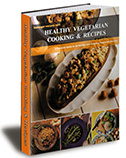Foods must be prepared sensibly to keep their flavor and food value. Unwise preparation and cooking methods can destroy valuable vitamins, ruin food texture, or add too much unnecessary fat, sugar, or salt.
One of the most common, unnecessary cooking practices is adding salt or sugar to food. Many cooks automatically pour salt, or sometimes sugar, into boiling water before vegetables or pasta are added. Many people shake salt on or rub it into meat before it is broiled or roasted. Children will not miss these if they do not become accustomed to them early. A delicate hand with salt and sweeteners will make meals more healthful and flavors more subtle. Salt, for example, draws water out of foods, and valuable vitamins, minerals, protein, and carbohydrates dissolved in the water end up in the salted cooking water or in the pan. Too much also can disguise the natural flavors and sweetness of vegetables.
Fruits and Vegetables
Most fresh fruits and many vegetables are delicious when served raw, and they keep most of their nourishment this way. Raw fruit or vegetables can be mixed together in a salad, served in small pieces with a dip, or eaten whole as a snack.
Even washing can destroy some valuable vitamins and minerals. Fresh fruit and vegetables, therefore, should be rinsed quickly under running water and not soaked. If fruit or vegetables, however, are caked with dirt, have pesticide or fertilizer residues on the surface, or have been coated with wax they should be scrubbed well under running water. It may be necessary to remove the peel before using them. In addition, breaking apart fresh fruit and vegetables initiates an enzyme reaction that can destroy vitamin C; therefore, cutting, tearing, or chopping should be delayed until just before they are to be used.
Cooking fresh fruit and vegetables decreases their food value, but the loss can be kept to a minimum if wise cooking methods are practiced. For example, the less water used and the less time the produce is cooked, the more nutrients are retained. Many important vitamins and minerals dissolve in water, so when food is placed in water, some nutrients are drawn out of the food and go into the water.
Cooking vegetables and fruits in a microwave oven is a good way to save vitamins and minerals because little or no water is used. Pressure cooking and steaming produce also are good cooking methods because the food does not come into direct contact with water. Some vitamins and minerals, nevertheless, are lost in the steam. If the cooking water is used in that same meal – in soups, gravies or sauces, for example – then the nutrient loss is decreased. Stir frying (cooking food quickly in hot oil) is another cooking method that leads to minimum vitamin and mineral loss. The fat adds extra calories to the vegetables, so only small amounts of polyunsaturated fats should be used if this cooking method is chosen.
If fruits and vegetables must be boiled, they should be cooked for a short time in as little water as possible, and the cooking water used during the meal. Vegetables and fruit cooked in the skin keep more of their vitamins and minerals than if they are peeled first. Potatoes, beets, carrots, turnips, and other root vegetables, which may have some dirt on the surface, can be scrubbed well rather than peeled.
Fewer vitamins and minerals are lost if vegetables or fruit is cooked whole or cut in large pieces. They should be cooked just before they are to be served and should not remain in the cooking water for a long time because vitamins and minerals will leach out. Baking soda (sodium bicarbonate) added to cooking water may keep vegetables bright green, but it destroys much of the vitamin C and thiamin in the food.
Frozen fruits and vegetables are the next best thing to fresh. Defrosting them before cooking loses vitamins and minerals. As with fresh, frozen fruit and vegetables should be cooked in as little water as possible, for a short period of time, and the cooking water should be used in the same meal whenever possible.
Vitamin and mineral loss is greatest with canned fruit or vegetables because they usually are packed in water. If the liquid from the can is added to a gravy or boiled down into a sauce and poured over vegetables, some of the vitamins and minerals can be recaptured.
Almost any kind of processing, such as refrigerating, freezing, canning, or cooking, will lead to loss of some valuable vitamins and minerals in food. In addition, processing often adds undesirable ingredients, such as sodium, to food. For example, fresh, raw green beans are low in sodium, high in vitamin A, and contain some vitamin C. Canned green beans have considerable sodium and less vitamin C, which is water soluble. The vitamin A content changes little because this vitamin is fat soluble. Fresh cooked and frozen cooked green beans are comparable.
If fresh beans are to be used immediately, then they probably have higher food value than frozen. If they will sit in the refrigerator for several days before they are cooked, then the level of some vitamins and minerals may decrease; therefore, the frozen variety may be better. Vegetables for freezing are picked when they are ripe, which is when they are at the peak for vitamin and mineral content, and then quickly frozen to preserve nutrients.
For new ideas on cooking delicious and healthy food, visit lowsugar-recipes.com.
Tags: fruits, vegetables
